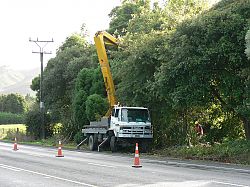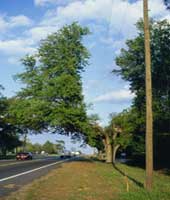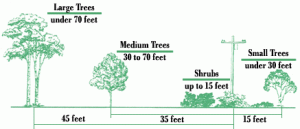 With hurricane season upon us, evidence of preparation is all around us.
With hurricane season upon us, evidence of preparation is all around us.
Tree trimmers, contracted by the local electrical utility companies, have been removing trees, branches and other vegetation that is “too close” to power lines. Many homeowners are concerned over the practice.
In order to prevent power outages, the federally approved Vegetation Management Reliability Standard, FAC-033-2, requires utilities to manage vegetation growth along the path of power lines to prevent contact. A minimum clearance of fourteen (14) feet between trees and transmission lines in the right-of-way must be maintained at all times in order to achieve service reliability and public safety.
By Florida Statute 163, an electric utility is granted easement or right-of-way on private property in order to build and maintain electric power lines. Vegetation maintenance allows for the mowing of vegetation within the right-of-way, removal of trees or brush within the right-of-way and selective removal of tree branches that extend within the right-of-way by the electric utility personnel, licensed contractors or International Society of Arboriculture (ISA) Certified Arborists. The choice of how to trim trees and manage vegetation growth near a power line (e.g. pruning, herbicides, or tree removal) is primarily made by the electric utility, subject to state and local requirements and laws, applicable safety codes, and any limitations or obligations specified in right-of-way agreements. An individual may contact the utility company to obtain a copy of the right-of-way agreement for their property.
 Sometimes, it appears to some that excessive vegetation has been removed. But, remember the utility companies are required to maintain the appropriate clearance “at all times.” For example, in the summer, power lines sag as they expand from rising air temperatures and heavy use. Also, wind and future growth must be taken into account when determining where to prune. Electric utilities usually prune or remove vegetation to a distance greater than the minimum clearances to account for all these factors.
Sometimes, it appears to some that excessive vegetation has been removed. But, remember the utility companies are required to maintain the appropriate clearance “at all times.” For example, in the summer, power lines sag as they expand from rising air temperatures and heavy use. Also, wind and future growth must be taken into account when determining where to prune. Electric utilities usually prune or remove vegetation to a distance greater than the minimum clearances to account for all these factors.
Tree trimming around power lines may seem like a local issue, but vegetation growth also affects interstate transmission lines. The U.S. Department of Energy estimates that electric utility service interruptions cost businesses and communities tens of billions of dollars annually. Tree contact with transmission lines was the leading cause of the August 2003 blackout that affected 50 million people in the Northeastern United States and Canada. In fact, that particular blackout prompted Congress to pass the Energy Policy Act of 2005, which lead the Federal Energy Regulatory Commission (FERC) to establish the Vegetation Management Reliability Standard.
 Should we have a storm that impacts Northwest Florida, remember that the clearing of trees and branches provides faster access for first responders, line repair crews, and other emergency service personnel. So, as you watch the preparation work being done, think about where you will be planting a tree so that it can reach full maturity without threatening power lines, therefore, not requiring “ugly pruning!”
Should we have a storm that impacts Northwest Florida, remember that the clearing of trees and branches provides faster access for first responders, line repair crews, and other emergency service personnel. So, as you watch the preparation work being done, think about where you will be planting a tree so that it can reach full maturity without threatening power lines, therefore, not requiring “ugly pruning!”
- Watch for “Melting Grass” - February 19, 2025
- Palms Can Suffer in the Cold - January 30, 2025
- Camellia Care - January 9, 2025
